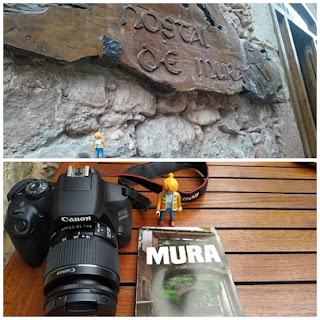 |
| Mayte visits Mura, Bages |
The Grandma has arrived to Talamanca after visiting Mura, another beautiful village near Talamanca. There, The Grandma has joined her closer friend Mayte who had been spending some days visiting and taking some photos of this wonderful zone.
Both friends have visited Sant Llorenç de Munt i l'Obac Natural Park, an amazing natural place full of beautiful views, incredible places and historical buildings.
During the travel from Barcelona to Mura, The Grandma has started to read a new novel titled The Garden Party and Other Stories and written by Katherine Mansfield.
Mura is a village, head of the municipality of the same name, in the south-east of the Bages county, already in contact with the Moianès and the Vallès Occidental. Located 454 m above sea level, it is one of the main entrance doors to the Sant Llorenç del Munt and l'Obac Natural Park.
The municipality of Mura has a territory broken by ranges with abundant woods of pine trees, holm oaks and oaks, numerous fountains and picturesque places. The town is grouped mostly in the village of Mura, presided over by the Sant Martí church, Romanesque and well restored, from which the apses stand out for their ornate arcades with capitals.
Mura forms a pleasant set of pavilions and paved streets, and stone houses, many of which have been prepared for holidays or weekend stays, due to the interest of the surroundings and the possibilities it offers the immediate natural park. Near Mura, in a framework of scattered farmhouses, stands out the unusual place of the hill of the Balma, with buildings built in a large rock that houses a small museum and an agrotourism center.
Mura forms a pleasant set of pavilions and paved streets, and stone houses, many of which have been prepared for holidays or weekend stays, due to the interest of the surroundings and the possibilities it offers the immediate natural park. Near Mura, in a framework of scattered farmhouses, stands out the unusual place of the hill of the Balma, with buildings built in a large rock that houses a small museum and an agrotourism center.
On the outskirts of the village is the Romanesque style church of Santa Creu de Palou.
More information: Ajuntament de Mura
Talamanca is a village, head of the municipality of the same name, in the Bages county. Old town, with narrow streets and slopes, and old houses well restored. Situated on a hill at 552 m above sea level and in the middle of Rossinyol Range.
 |
| Mayte visits Mura, Bages |
With Saracen invasions (711-715), the Bages had almost completely depopulated, and it was not until the repopulations carried out by the Comtes Borrell d'Osona (799-820) and Guifré el Pelós (878-897) that originating peasants from the north they settled around castles and churches looking for the double military and spiritual protection.
This should also be the function of the castle of Talamanca and the church of Santa Maria de Talamanca, which is already mentioned in 1038. Between the church and the castle were built houses that would form the town of Talamanca.
At the end of the 12th century, the feudal domain of the castle of Talamanca passed into the hands of the Talamanca, which was linked to the history of the town during the entire Middle Ages and began with Bernat de Talamanca and his wife Dolça (1186- 1209). The Talamanca were masters of the whole term. They bought, sold, granted farms and wilves as lords, not only of the land but also of men, who were sold all in the same lot.
More information: Talamanca
Later, the Talamanca began to establish relationships with the small nobility and the surrounding castles, and thus became associated with the Santa Coloma or Llavinera nobility.
An example of the prototype of the gentleman and feudal knight was Berenguer de Talamanca. He awarded honors, donated and participated in acts of violence against Guillem de Calders, in which King Jaume el Just even had to intervene.
 |
| The Grandma visits Talamanca, Bages |
In those years, the Calders family came into crisis and in 1336 the castle of Calders was sold to the Talamanca family. From the middle of the fourteenth century, with the great crisis of feudalism, the decay of the Talamanca began, coinciding with the ravages caused by black plague and the bad uses in the field. The Talamanca then came into contact with other families, such as the Planella (1675), the Eimeric or Aymerich, and finally, in the 18th century, the castle passed into the hands of the Marquesos of Castellbell (Marquisos).
In the area of the municipality between the town and the Mussarra range took place, between the days 13 and 14 of August of 1714, the battle of Talamanca, between the Austrians, under the orders of the Marquès del Poal, and the Bourbon , led by the Comte de Montemar. This episode of the War of Succession was the last success of the Austrians in Catalonia, before the final capitulations of Barcelona and Cardona during the following month of September.
More information: Fem Turisme
Sant Llorenç del Munt is a largely rocky mountain massif in central Catalonia. The highest summit, where the Monestir de Sant Llorenç del Munt is located, has an elevation of 1,104.2 metres above sea level and is known as La Mola.
Montcau, with 1,056.8 metres, is another important peak of the massif. On the massif, there is a protected area under the name Sant Llorenç del Munt i l'Obac National Park.
More information: Diputació de Barcelona
A national park is not a playground.
It's a sanctuary for nature and for humans
who will accept nature on nature's own terms.
A national park is not a playground.
It's a sanctuary for nature and for humans
who will accept nature on nature's own terms.
Michael Frome
No comments:
Post a Comment